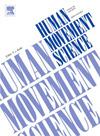Effect of verbal reinforcement on electromyographic activity and performance in the traditional front plank exercise
IF 1.9
3区 心理学
Q4 NEUROSCIENCES
引用次数: 0
Abstract
Background
Verbal reinforcement may influence neuromuscular responses during exercises, but its specific effects on electromyographic activity and performance during the traditional front plank exercise remain unclear. This study aimed to investigate the effects of verbal reinforcement on muscle activation amplitude, median frequency, execution time, and perceived exertion during the front plank exercise.
Methods
Thirty physically active adults performed the front plank under two randomized conditions: with and without verbal reinforcement. Electromyography signals were processed to extract amplitude and median frequency using a 1-s window and analyzed with quadratic polynomial models.
Findings
While no significant differences were found between conditions with and without verbal reinforcement in electromyographic amplitude or median frequency (p > 0.05), significant differences were observed among muscles in amplitude and frequency coefficients. Verbal reinforcement led to significantly longer execution time (median: 125.9 s vs. 97.0 s, p < 0.001; Cohen's d = 0.49, moderate effect) and increased perceived exertion (odds ratio: 5.09; p = 0.03; Cohen's d = 0.29, small effect).
Interpretation
These findings suggest that verbal reinforcement does not alter electromyographic behavior; however, it enhances performance duration and perceived exertion, supporting its use in isometric core training.
言语强化对传统平板支撑运动中肌电活动和表现的影响
语言强化可能会影响运动中的神经肌肉反应,但其对传统前平板支撑运动中肌电活动和表现的具体影响尚不清楚。本研究旨在探讨言语强化对前平板支撑运动中肌肉激活幅度、中位频率、执行时间和感知力道的影响。方法30名身体活跃的成年人在有和没有言语强化的随机两种情况下进行前平板支撑。采用1-s窗对肌电信号进行处理,提取振幅和中位数频率,并用二次多项式模型进行分析。结果发现,在有和没有言语强化的情况下,肌电图振幅或中位数频率没有显著差异(p >;0.05),不同肌肉间振幅系数和频率系数差异显著。言语强化导致执行时间显著延长(中位数:125.9 s vs. 97.0 s, p <;0.001;Cohen’s d = 0.49,中等效果)和感觉劳累增加(优势比:5.09;p = 0.03;Cohen’s d = 0.29,影响较小)。这些发现表明言语强化不会改变肌电图行为;然而,它提高了性能持续时间和感知运动,支持其在等距核心训练中的使用。
本文章由计算机程序翻译,如有差异,请以英文原文为准。
求助全文
约1分钟内获得全文
求助全文
来源期刊

Human Movement Science
医学-神经科学
CiteScore
3.80
自引率
4.80%
发文量
89
审稿时长
42 days
期刊介绍:
Human Movement Science provides a medium for publishing disciplinary and multidisciplinary studies on human movement. It brings together psychological, biomechanical and neurophysiological research on the control, organization and learning of human movement, including the perceptual support of movement. The overarching goal of the journal is to publish articles that help advance theoretical understanding of the control and organization of human movement, as well as changes therein as a function of development, learning and rehabilitation. The nature of the research reported may vary from fundamental theoretical or empirical studies to more applied studies in the fields of, for example, sport, dance and rehabilitation with the proviso that all studies have a distinct theoretical bearing. Also, reviews and meta-studies advancing the understanding of human movement are welcome.
These aims and scope imply that purely descriptive studies are not acceptable, while methodological articles are only acceptable if the methodology in question opens up new vistas in understanding the control and organization of human movement. The same holds for articles on exercise physiology, which in general are not supported, unless they speak to the control and organization of human movement. In general, it is required that the theoretical message of articles published in Human Movement Science is, to a certain extent, innovative and not dismissible as just "more of the same."
 求助内容:
求助内容: 应助结果提醒方式:
应助结果提醒方式:


